Pulmonary nitric oxide in mountain dwellers
| dc.contributor.author | Beall, Cynthia M | |
| dc.contributor.author | Laskowski, Daniel | |
| dc.contributor.author | Strohl, Kingman | |
| dc.contributor.author | Soria, Rudy | |
| dc.contributor.author | Villena, Mercedes | |
| dc.contributor.author | Vargas, Enrique | |
| dc.contributor.author | Alarcón, Ana María | |
| dc.contributor.author | Gonzales, Cristina | |
| dc.contributor.author | Erzurum, Serpil C | |
| dc.date.accessioned | 2017-02-22T13:50:14Z | |
| dc.date.available | 2017-02-22T13:50:14Z | |
| dc.date.issued | 2001-11-22 | |
| dc.identifier.uri | http://repositorio.umsa.bo/xmlui/handle/123456789/9725 | |
| dc.description.abstract | Nitric oxide is synthesized in the lungs to help regulate blood flow, and its levels have been found to drop in species native to low altitudes, including humans, upon acute exposure to reduced oxygen concentration1–3. But we show here that exhalation of nitric oxide by chronically hypoxic populations of Tibetans living at 4,200 m and of Bolivian Aymara at 3,900 m is unexpectedly increased compared with a low-altitude reference sample from the United States. This consistent response in two far-removed, high-altitude locales indicates that increasing the concentration of nitric oxide in the lungs may represent a means of offsetting hypoxia. | es_ES |
| dc.language.iso | en | es_ES |
| dc.publisher | NATURE | es_ES |
| dc.subject | OXIDO NÍTRICO PULMONAR | es_ES |
| dc.subject | HABITANTES DE LAS MONTAÑAS | es_ES |
| dc.title | Pulmonary nitric oxide in mountain dwellers | es_ES |
| dc.type | Article | es_ES |

